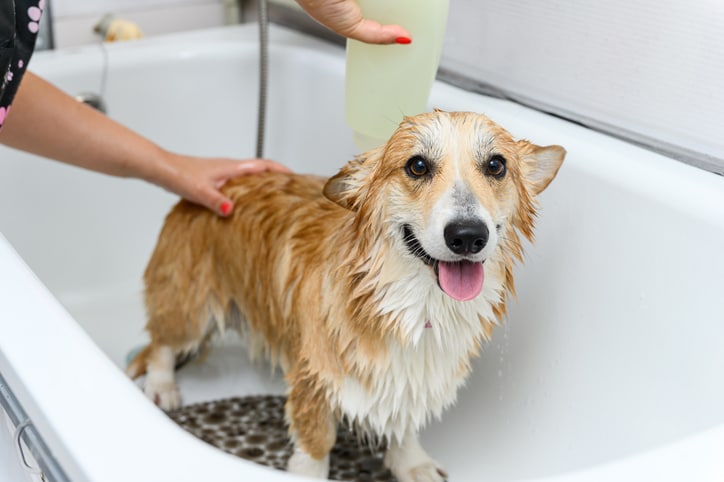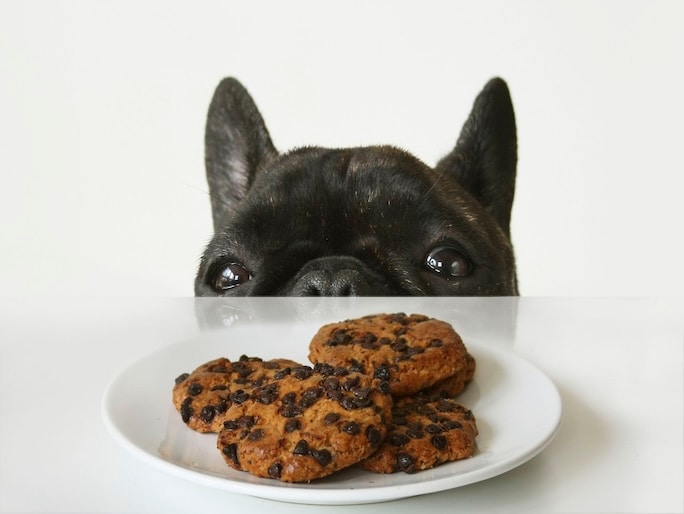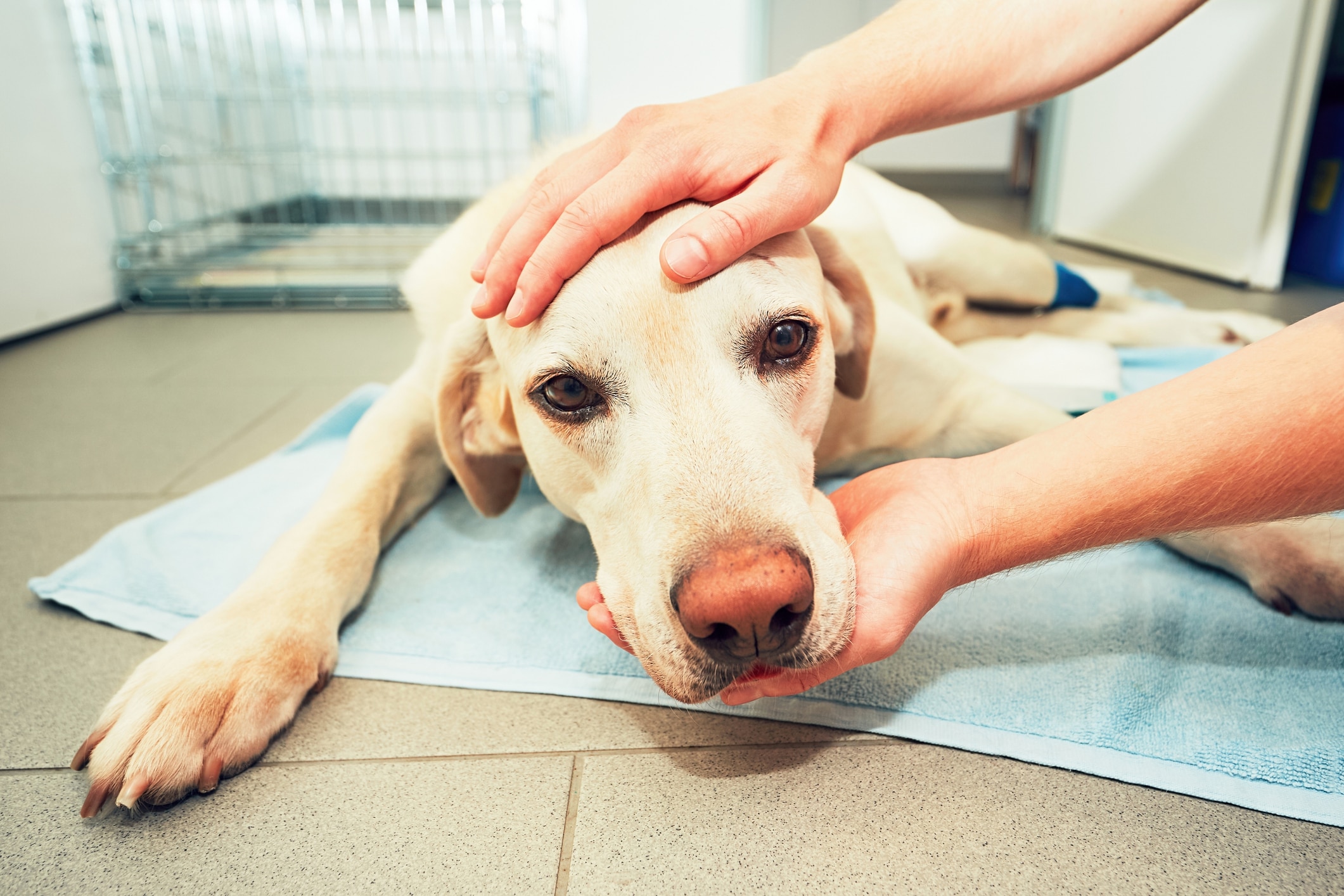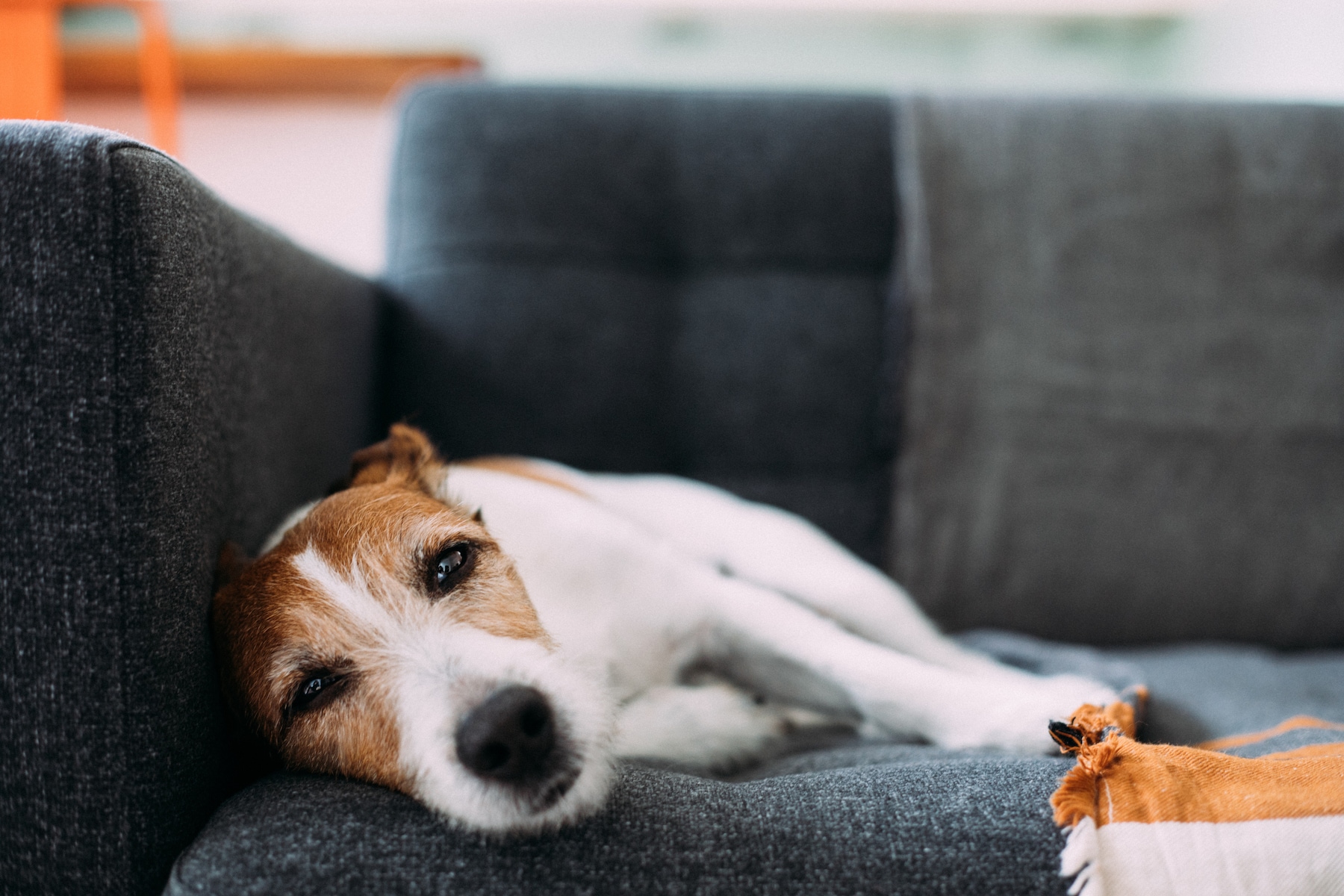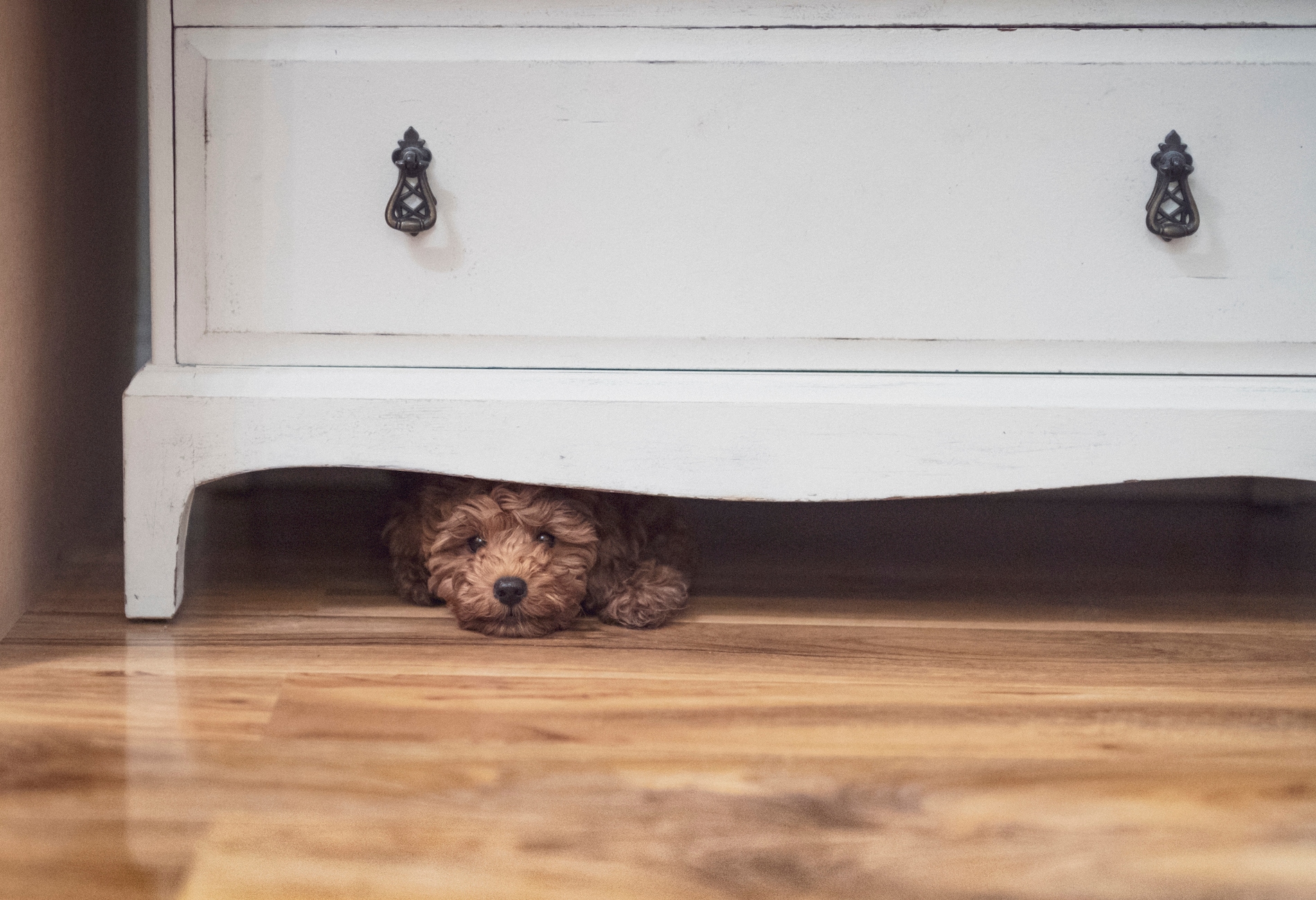In this article
Whether you’re a pet parent or a pet sitter, knowing how to bathe a dog at home is a skill that’s bound to come in handy when your dog (or your client’s dog) decides to roll in something stinky when the local groomer is closed. Bathing your dog regularly at home, rather than putting it off until grooming appointments, can also help keep odor, dander or skin issues under control.
“Sometimes a person’s allergies make it so that frequent bathing of their pup helps them breathe easier,” says Dr. Jamie Clanin, veterinary advisor for PetLab Co. “Other times, a dog may need to be bathed frequently for their own medical reasons. There are plenty of good reasons to learn how to bathe your dog at home.”
Here’s how to easily and efficiently bathe a dog at home while minimizing mess and stress for both you and your pup, according to veterinarians.
Key takeaways
- To bathe a dog at home, make sure you have dog-safe shampoo, towels, treats, and a safe space, like an enclosed shower or bath with a detachable head. Treats are also helpful to keep the dog calm.
- Humans and dogs have different oils and acids on the surface of their skin, so make sure to use a shampoo designed especially for dogs.
- Use towels to dry dogs as possible and let nature and time take care of the rest. Dogs with water-resistant outer coats like Golden Retrievers and German Shepherds will take longer but should dry within a day.
- Most dogs can be bathed every one to two months, with wiping or spot-cleaning between baths as needed. Dogs have sensitive skin, so it’s best not to overwash them.
What supplies do you need to bathe a dog at home?
Before bringing the dog into the bathroom, make sure you have all your supplies within arm’s reach. That way, you won’t be searching for the shampoo while struggling to keep a wet, wriggly pup from hopping out of the tub.
You’ll need the following supplies to bathe your dog at home, according to our experts:
- Non-slip bath mat.
- Rinse cup and/or detachable shower head.
- Dog shampoo and conditioner.
- Cotton balls.
- Ear cleaner.
- Towels.
- Treats.
If you’re caught in a stinky situation and don’t have dog shampoo on hand, you might be tempted to borrow some of your own bath products; however, this isn’t the best solution. “Humans and dogs have different oils and acids on the surface of their skin, so make sure to use a shampoo designed especially for dogs. Even baby shampoo isn’t designed for non-human babies,” says Clanin.
Using human shampoo on a dog can alter their skin’s pH level, potentially causing dryness and itching and may make their skin more vulnerable to infection. Instead, try these homemade dog shampoo recipes that can be made using ingredients you likely have in your kitchen.
How to bathe a dog at home, step-by-step
Once you’ve gathered your supplies and brought your dog into the bathroom (with the door closed!) you’re ready to get started.
1. Protect your dog’s ears
Dogs have long, L-shaped ear canals that are prone to trapping moisture that allows infection-causing bacteria and fungi to overpopulate, especially in dogs with long, floppy ears like hounds and spaniels. “To help avoid water in your dog’s ears, you can put a cotton ball gently in the opening of the ear during a bath. Just be sure to remove it afterward and switch it for a dry one if it does get wet,” says Clanin.
2. Set the water temperature to lukewarm
Double check the temperature before wetting your dog’s coat with your rinse cup or detachable shower head. It’s best to let the water drain while you wash your dog, no need to fill the tub. “Having them stand in water prevents you from getting them as clean as possible and will make the process scarier for them,” notes Clanin. “Especially for puppies and small-breed dogs, even a couple of inches of water could be like us going in up to our waist.”
3. Work shampoo through your dog’s skin and coat
Gently scrub shampoo into the dog’s coat, moving against the natural direction of the fur to loosen dirt and oils. Clanin also recommends using a washcloth to clean your dog’s face, avoiding direct pouring that can trigger anxiety and may cause water or soap to enter the ear canal.
“Use treats and gentle, reassuring tones to create positive associations [with bathing].”
—Dr. Kathryn Dench, veterinarian
4. Rinse completely
Make sure no traces of shampoo are left behind. Shampoo residue can irritate your dog’s skin and lead to itching after grooming, notes Dr. Kathryn Dench, a veterinarian and chief scientific advisor at Paw Origins.
5. Apply conditioner
If you’re using conditioner, apply it as directed. Some dog conditioners are leave-in, others require rinsing.
6. Be soothing and patient
Keep in mind that baths can be stressful for many dogs, especially for puppies and anxiety-prone pups. “Use treats and gentle, reassuring tones to create positive associations. For anxious dogs, consider a pheromone diffuser in the bathing area prior to the bath to help soothe their nerves,” says Dench.
How to dry your dog after a bath
After their bath, many dogs get a serious case of the zoomies. They may run around, roll and rub up against every soft surface they can find in attempts to get dry. If you don’t act fast, they’ll imbue your home with dampness and eau de wet dog -— the harmless though mildly offensive odor that results when the bathwater activates the benign yeast and bacteria that live on your dog’s skin.
Towel dry as much as possible
“Use towels to dry them as much as possible and let nature and time take care of the rest,” says Clanin. “Short-haired dogs like Dalmatians or Boxers will dry very quickly this way. Dogs with water-resistant outer coats like Golden Retrievers and German Shepherds will take longer but should dry within a day.”
Use a hair dryer for long, dense coats
Dench adds, “Towel-drying is usually sufficient for most dogs, but for those with longer or denser coats, a hair dryer set on a cool or low heat setting can be used. Be sure to keep the dryer at a safe distance to avoid overheating or burning the skin.”
Pay attention to weather and routines
“Dogs with especially thick coats like Huskies or Great Pyrenees may take several days to dry completely, so bathe these dogs only when the weather is safe for them to continue their daily activities,” Dench says. “A quick walk outside should be fine in above-freezing temperatures, but they should not be out for long or in particularly cold air until they are dry.”
How often should you bathe a dog?
Most dogs can be bathed every one to two months, with wiping or spot-cleaning between baths as needed. Dogs have sensitive skin that can be prone to irritation due to overwashing. It’s best to wait at least a few weeks between baths to avoid drying out the skin’s moisture barrier.
“If you use a topical flea and tick control, avoid bathing as much as possible until the next dose is due.”
—Dr. Jamie Clanin, veterinarian
“Generally, dogs should be bathed once every four to six weeks. However, this can vary based on the dog’s breed, skin type and level of outdoor activity,” says Dench. “For instance, dogs with oily coats like Basset Hounds may require more frequent baths, while breeds with water-repellent coats, such as Golden Retrievers, should be bathed less often to preserve their natural oils.”
“If you use a topical flea and tick control, avoid bathing as much as possible until the next dose is due. Many of these medications … work by mixing with the natural oils on your dog’s skin. If you remove these oils with a bath, the flea and tick prevention will be less effective,” says Clanin. “The best way to avoid this problem is to only bathe your pup when they are due for their next dose of medication, so you don’t have to worry about washing it off.”
